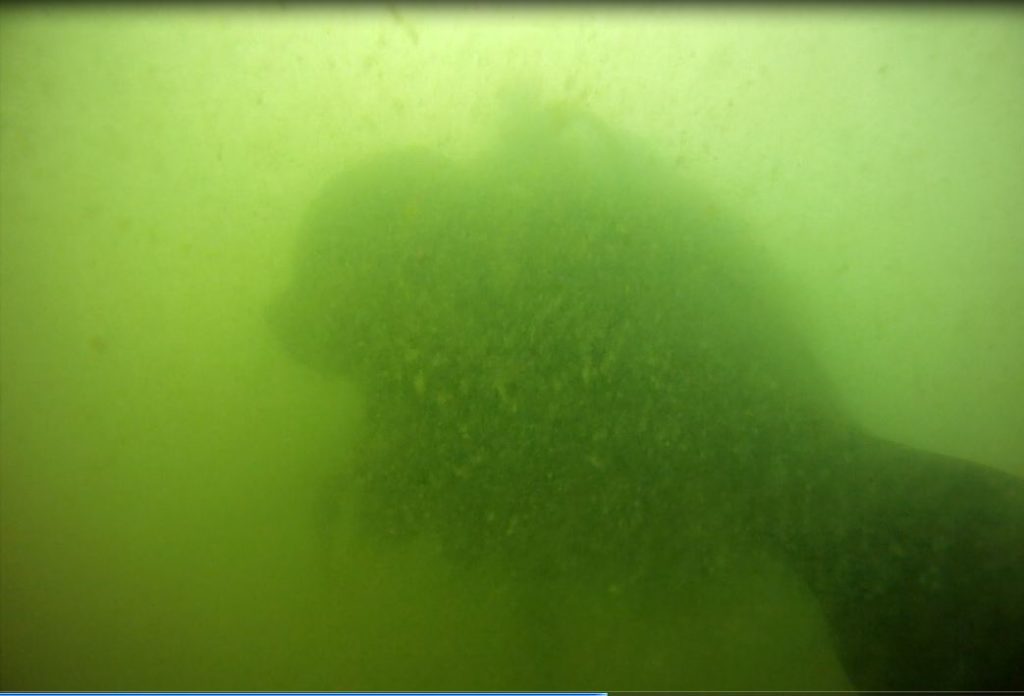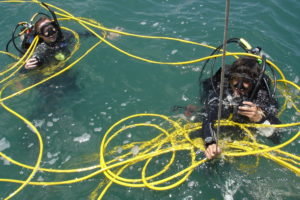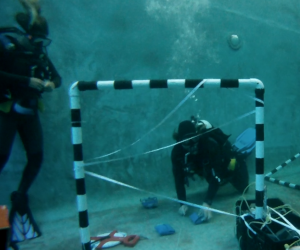As we begin to move into our 2016 field season, we are excited to introduce the results of the 450th Anniversary Shipwreck Survey, that the Lighthouse Archaeological Maritime Program (LAMP) carried out over the 2015 field season. The “450th Anniversary Shipwreck Survey” was a project carried out as part of LAMP’s multi-year First Coast Maritime Archaeology Project, which has been ongoing since 2007. The 450th Anniversary Shipwreck Survey, named in honor of St. Augustine’s 450th anniversary which occurred in 2015, was funded by a State of Florida, Division of Historical Resources Small Matching Grant (No. S1604).
Previous Posts:
Once the magnetometer data had been analyzed and the most promising targets chosen for further investigation, it’s time to put divers in the water and see what these targets reveal!
While we often experience a wonderful week or two of decent visibility during our summer field seasons, diving off of St. Augustine is more often than not a dark and murky experience. This, coupled with the nature of scientific diving in general, creates a challenging diving environment for our archaeologists and volunteers.
During the 450th Anniversary Shipwreck Survey, we were lucky enough to have those two weeks of decent visibility, but for the rest of the project, our divers were diving in the dark.
One of our newest volunteers, Kira Sund, joined the Lighthouse Archaeological Maritime Program (LAMP) dive team for the first time during the project. Keep reading to see what Kira has to say about diving conditions off of St. Augustine, from the perspective of a brand new scientific diver!

As Kira says, “water so green, you can’t always see your hand extended in front of you.” The visibility in this image would be considered ‘good’ compared to many of the days we have spent diving in near darkness.
Going in Blind
By Kira Sund

Divers must learn to work around these yellow hookah hoses, lest they tangle themselves in the coils.
Diving in St. Augustine can be a bizarre experience to the newcomer. For me, my previous experience in diving had been limited to SCUBA diving in the Red Sea, with beautifully clear waters descending to 60 ft or more.
So it was a bit of a change to back roll off of a dive boat into waters so green you can’t always see your hand extended in front of you; even while diving at 30 ft or less.
Then, there is the use of hookah lines, air hoses that connect you to the boat, providing you with a constant air supply. The advantage of this is longer time on site, but there is the added complication of avoiding tangling the lines or catching the hoses on other equipment.
This all lends to St. Augustine scientific dives being more complicated than diving some of the common recreational sites.
The Lighthouse Archaeological Maritime Program (LAMP) at the St. Augustine Lighthouse & Maritime Museum prepares for these conditions through preliminary testing in a pool setting; divers duct tape their masks until no light is visible and must complete a series of tasks in the total darkness. These tasks include traversing an obstacle course, removing dive gear, and untangling from rope.
By first doing these in a controlled setting, divers are then better prepared for emergencies that could occur in low light conditions and for tasks as seemingly simple as following lines to the excavation site.
Underwater Obstacle Course
Divers are blindfolded before entering the pool to allow no foreknowledge of the course. Although being led in total darkness to the edge of a pool, being assured you have reached the edge of the pool, and blindly stepping while forward, all the while trusting the water to catch you can be a bit disconcerting, it is also an amazing experience and remarkably fun.

The black out mask obstacle course in the pool helps train divers to work calmly in poor visibility environments.
On a normal day this preparation helps as the current sweeps you off the guide line and you struggle to find it, even though you know it is mere inches away; also as you clip and unclip gear that, if dropped, would never be found again; or even as you set up the grid to excavate, finding your way by compass.
This type of preparation is important even on clearer days during periods of excavations; the sites are excavated using dredges which along with clearing material out of the site can have the added effect of clouding up the area. Visibility can drop to the point that leaning within inches is the only way to see what you are working on.
Erring on the Side of Caution
All dives, even the ones using hookah lines, are accompanied by SCUBA tanks as a safety precaution. If the circuit breaker flips on the boat, the air compressor will shut off, rendering the hookah lines non-functional. In these circumstances, the diver will switch to their SCUBA regulator and continue work.
During one of my first dives with LAMP, I encountered this issue; breathing through the hookah quickly became challenging, as though I was trying to inhale through a plastic bottle. Some air is still in the hose, just not enough to get through. It only takes a moment to swap to SCUBA and return to the task at hand.
During one of the later dives while working with the dredges, one of the hookah lines became partially buried under the dredged out material; this can have the obvious side effect of making surfacing more challenging as you get pulled short halfway up. It only takes a few minutes to follow the hose back to the problem; far less time than would be spent having to surface to get fresh tanks or having to get all the tanks refilled at the end of the day.
Risks are Worth the Reward
As with any job there are some risks involved, but, through appropriate planning and preparation, these can be minimized. Diving in low visibility can be an incredible experience as shapes suddenly materialize through the green haze.
It might not be the most ideal conditions for collecting data, but you don’t get to choose what circumstances you work in, only how you respond to them.

